ChrisCosta416
Well-known member
Well, after many vehicles I am back to a Mitsubishi again!
Introducing my new to me 2020 Mitsubishi Outlander Plug in Hybrid! Picked her up with about 15,000 miles and qualified for the used EV tax credit bringing this vehicle to about 22k after taxes! I will be documenting the build here and hoping to make more folks aware about this platform!

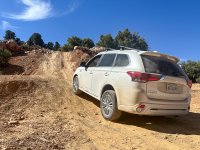
Why a Mitsubishi Outlander PHEV?
One of the most asked questions I get is - "Why?" Especially after moving to a 200 Series Lexus LX570. I will try to answer this is a few bullet points as possible.
What are your plans?
My goal of this "build" is to turn this into a soft roader that will allow me to fancy car camp, daily drive to work, and take on some mild (mild for true 4wds) trails.
The "build"...
I have built quite a few 4wds and have learned less is more. I got caught up in the overland craze when I got my first Montero, but I have since learned my lesson and realized less is more I have seen far too many crossovers lugging around heavy oversized tires and gear only to not use it and instead put more stress on the drive-train and components.
I have seen far too many crossovers lugging around heavy oversized tires and gear only to not use it and instead put more stress on the drive-train and components.
Tires...
When I picked up the vehicle it was equipped with the original Bridgestone Ecopia tires in size 225/55R18 and it rode rough! So I decided to opt for Michelin Defender 2s, though not the same as Michelin Defender LTX M/S (not available in the size I wanted) they feature a tougher sidewall and close to the same tread pattern as the Defender LTX. I opted to go up only one aspect ratio - 225/60/18. Since installing the tires, I have a smooth and quiet ride and have no impact to my EV range. One thing I did notice and is the vehicle struggled on what to me looked to be a relatively easy hill to climb. I have not narrowed it down to tires quite yet.
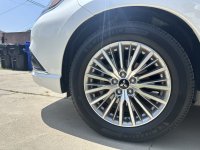
Suspension...
The Outlander utilizes independent suspension similar to the last gen Evo. It features Macpherson struts in the front with a coilover shock in the rear with an stem top mount and eyelet bottom mount. In my opinion the coils on the Outlander PHEV are way to soft from the factory, when getting up to highway speeds the car loves to jump around and often feels un-controlled. However on dirt roads it feels quite soft. I purchased and was planning to do a 30mm top-hat spacer from Tema4x4 but discovered JAOS makes a progressive coil for the front and rear giving the Outlander a lift height of about an inch all around. There are multiple companies who make lifted and lowered coils in Japan but I opted for a brand with a reputation for making quality products. I was briefly looking at the OEM Mitsubishi/Bilstein shocks available on the GSR spec in Australia but decided against it due to cost, availability and reviews of early failures. Installing of the JAOS coils was easy, the most time consuming part was pulling the rear interior.

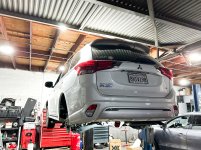
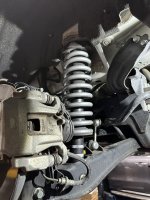

Underbody...
A big concern I had was the the vehicle traction battery (EV battery pack) being so vulnerable. ASFIR makes a skid plate for the front but no one made a battery skid plate for the Outlander. In fact from my research no one makes skid plates for PHEVs in general, even the Rav4 Prime has an exposed battery pack. The battery on the PHEV has a coating to protect it from light debris but the coolant hoses for the HVAC, and battery warming are completely exposed. I was able to get that solved as Road Race Engineering just happen to have the skid plates from the Outlander PHEV from the Rebelle Rally. A few instagram DMs and a few days later I had them installed! Road Race Engineering designed these as a request by Mitsubishi Motors North America for the Outlander PHEV that participated in the Rebelle Rally. They are made of aluminum and also featured a bent design to keep the single catalytic converter cool mimicking the OEM fiberglass skid plate.
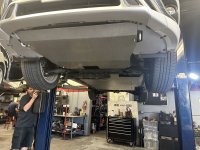
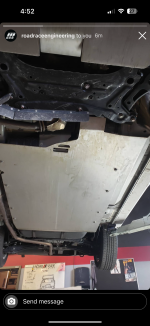
That's it for now!
I plan to keep this updated with more adventures, experiences and tech info!
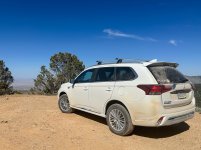
Introducing my new to me 2020 Mitsubishi Outlander Plug in Hybrid! Picked her up with about 15,000 miles and qualified for the used EV tax credit bringing this vehicle to about 22k after taxes! I will be documenting the build here and hoping to make more folks aware about this platform!


Why a Mitsubishi Outlander PHEV?
One of the most asked questions I get is - "Why?" Especially after moving to a 200 Series Lexus LX570. I will try to answer this is a few bullet points as possible.
- Value - I think it is well known that Mitsubishi does not hold their value well compared to Toyotas and this makes Mitsubishis a great value for what you get!
- Options - This goes hand in hand with value as well. For the money spent you get a relatively new vehicle with low miles, modern creature comforts, a superb all wheel drive system, and great warranty.
- Fuel Economy - So I drive A LOT. Around 20k-30k miles a year... So driving my 2011 Lexus LX570 that gets about 15-17MPG on a good day was not cutting it for me, in fact I drove that vehicle all over the southwestern US and put about 30k miles on it within a year. Once I calculated the gas mileage I had to rethink my life choices

- Reliability - The Mitsubishi Outlander PHEV is the best selling PHEV in Europe for many reasons, one of those reasons is its ability to be a reliable daily driver. You can find many examples of the Outlander PHEV making it to 200k miles or more with nothing more than fluid changes. The 4B11 motor has a great track record for reliability.
- Capability? - Ok so I do not have many examples on how capable this vehicle is. We did take one to Monache Meadows and it only required assistance once, but one also completed the Rebelle Rally and various other rallies in Europe. My goal is to see just how capable the Outlander PHEV really is!
What are your plans?
My goal of this "build" is to turn this into a soft roader that will allow me to fancy car camp, daily drive to work, and take on some mild (mild for true 4wds) trails.
The "build"...
I have built quite a few 4wds and have learned less is more. I got caught up in the overland craze when I got my first Montero, but I have since learned my lesson and realized less is more
Tires...
When I picked up the vehicle it was equipped with the original Bridgestone Ecopia tires in size 225/55R18 and it rode rough! So I decided to opt for Michelin Defender 2s, though not the same as Michelin Defender LTX M/S (not available in the size I wanted) they feature a tougher sidewall and close to the same tread pattern as the Defender LTX. I opted to go up only one aspect ratio - 225/60/18. Since installing the tires, I have a smooth and quiet ride and have no impact to my EV range. One thing I did notice and is the vehicle struggled on what to me looked to be a relatively easy hill to climb. I have not narrowed it down to tires quite yet.

Suspension...
The Outlander utilizes independent suspension similar to the last gen Evo. It features Macpherson struts in the front with a coilover shock in the rear with an stem top mount and eyelet bottom mount. In my opinion the coils on the Outlander PHEV are way to soft from the factory, when getting up to highway speeds the car loves to jump around and often feels un-controlled. However on dirt roads it feels quite soft. I purchased and was planning to do a 30mm top-hat spacer from Tema4x4 but discovered JAOS makes a progressive coil for the front and rear giving the Outlander a lift height of about an inch all around. There are multiple companies who make lifted and lowered coils in Japan but I opted for a brand with a reputation for making quality products. I was briefly looking at the OEM Mitsubishi/Bilstein shocks available on the GSR spec in Australia but decided against it due to cost, availability and reviews of early failures. Installing of the JAOS coils was easy, the most time consuming part was pulling the rear interior.




Underbody...
A big concern I had was the the vehicle traction battery (EV battery pack) being so vulnerable. ASFIR makes a skid plate for the front but no one made a battery skid plate for the Outlander. In fact from my research no one makes skid plates for PHEVs in general, even the Rav4 Prime has an exposed battery pack. The battery on the PHEV has a coating to protect it from light debris but the coolant hoses for the HVAC, and battery warming are completely exposed. I was able to get that solved as Road Race Engineering just happen to have the skid plates from the Outlander PHEV from the Rebelle Rally. A few instagram DMs and a few days later I had them installed! Road Race Engineering designed these as a request by Mitsubishi Motors North America for the Outlander PHEV that participated in the Rebelle Rally. They are made of aluminum and also featured a bent design to keep the single catalytic converter cool mimicking the OEM fiberglass skid plate.


That's it for now!
I plan to keep this updated with more adventures, experiences and tech info!

Last edited:
